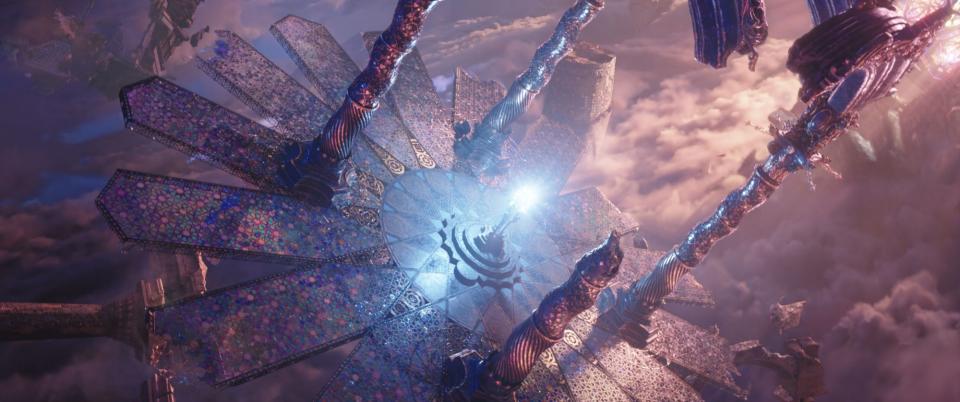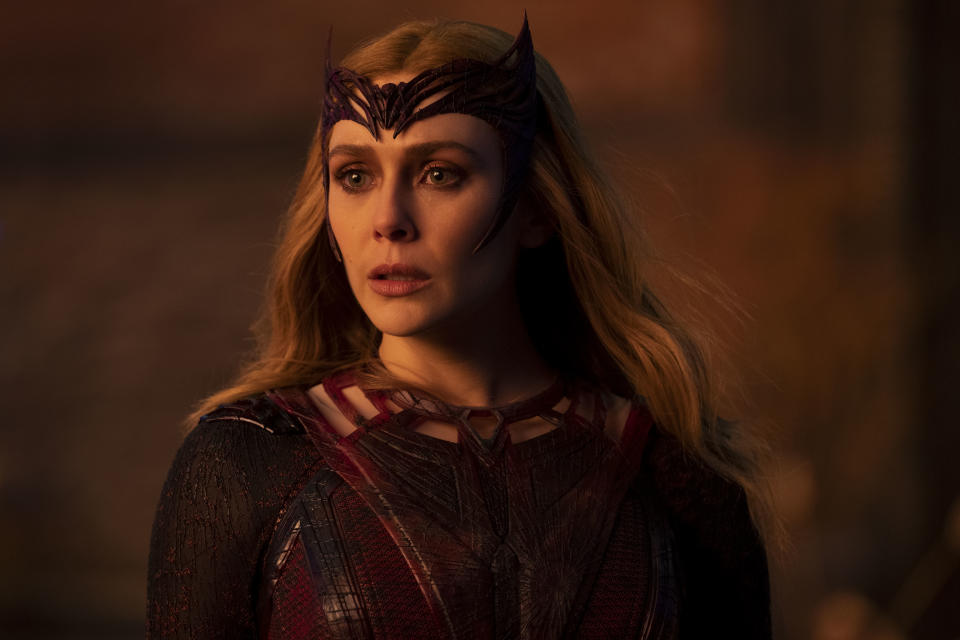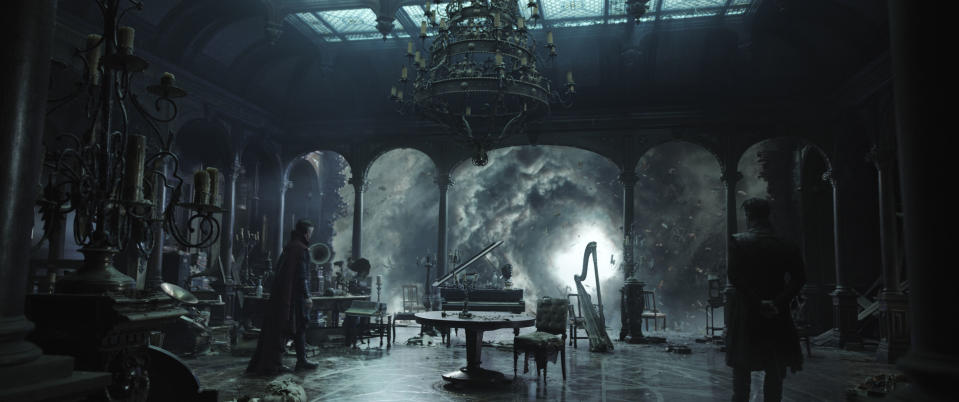‘Doctor Strange in the Multiverse of Madness’ Review: Sam Raimi Just Saved the MCU from Itself

- Oops!Something went wrong.Please try again later.
- Oops!Something went wrong.Please try again later.
“Sometimes one must break the rules in order to serve the greater good,” a character named The Ancient One proffered during a critical scene of 2016’s “Doctor Strange.” Spoken midway through the 14th installment of a culture-devouring mega-franchise that had already distilled blockbuster filmmaking down to a proprietary formula, that nugget of timeless wisdom carried all the weight and sincerity of an algorithm suddenly insisting that math were less instructive than poetry. Not even Tilda Swinton could make it add up.
While Marvel has since made more effective use of its recipe (“Black Panther”), and even feigned at allowing someone to make a different meal out of it (“Eternals”), the studio has also diluted Doctor Strange (“Spider-Man: No Way Home”) to the point that he began to seem like the last superhero in the Marvel Cinematic Universe who might anchor a movie that actually heeded The Ancient One’s teachings.
More from IndieWire
That’s why it felt like much ado about nothing when it was announced that Sam Raimi — whose ability to re-thread Silver Age spandex with a personal touch made his “Spider-Man” trilogy the ultimate proof-of-concept for the MCU’s product, as well as a prototype that it has still yet to match — had been hired to direct the first proper sequel to “Doctor Strange.” He’s arguably the most idiosyncratic stylist who’s ever made a Marvel movie without leaving over creative differences, but even the world’s giddiest tinkerer can only do so much when they’re stuck working an assembly line.
And truth be told, it would be seriously overstating the case to suggest that “Doctor Strange in the Multiverse of Madness” breaks the rules. In many of the multiplexes where it opens this weekend, it won’t even be the best or most audacious multiverse movie that includes a scene of a beloved actor being squirted with mustard in an alternate dimension where everyone walks differently.

Photo courtesy of Marvel Studios
But the fact remains that Raimi is a natural-born scrapper who’s always thrived on limitations. Many of his films (e.g. “The Evil Dead” and “A Simple Plan”) have tapped into a pure darkness underlying the seductive promise of infinite possibility, while others (take a wild guess) have displayed a deep conviction that power demands responsibility. He is, for those same reasons, the ideal person to offer Marvel the gentle gut-check it’s needed for so long, the ideal person to tell a story about what happens after you open Pandora’s box, and to do so in a way that allows the MCU and its fans to find a measure of peace in the idea that they have to move forward — no matter how much it hurts.
That’s not enough to make “Multiverse of Madness” a great movie, but it is enough to make it a real Sam Raimi movie. Slowly, gradually, and then with great enthusiasm, what begins as a staid tale of people hurling CGI at larger pieces of CGI while yammering on about whatever new thing is threatening all existence evolves into something less familiar: that makes good on the reckoning Chiwetel Ejiofor promised at the end of the original by cutting away the safety net that previous installments of the MCU have tried to pretend wasn’t there.
In the shadow of the programmatic corporate wank-fest/apologia that was last year’s “Spider-Man: No Way Home,” the giddy second half of Raimi’s carnivalesque sequel almost hits with the same undead thrill of watching “Evil Dead II” for the first time (the difference between Jon Watts and Sam Raimi is the difference between Bob Ross and Roy Lichtenstein). With all due respect to Kenneth Branagh’s dutch angles in “Thor” and Chloé Zhao’s well-documented insistence on lighting certain shots of “Eternals” with the same exact sun people use on the set of real movies like “Nomadland,” this is the first MCU movie in which many of the shots have legible fingerprints on them.
Even the film’s galaxy brain attempts at fan service, which include a few well-kept secrets this review wouldn’t dare to reveal, are eventually perverted to the point that hardcore Marvel heads and hate-watchers alike might find themselves cheering at the same volume (the result of a tongue-in-cheek approach that’s far more effective here, in the guise of a typical MCU movie, than it is in a juvenile satire like “Deadpool”).
If the meager ambitions of Michael Waldron’s (“Loki”) script hardly befit something with the word “Multiverse” in its title — most of the movie is split across a mere two dimensions, one of which is largely defined by an overabundance of flowers and some wacky traffic signals — Raimi’s anarchic touch makes the “what” of it all seem all but irrelevant. Ditto the “why.”
Rushed into production after he inherited the job from Scott Derrickson, the director had neither the time to ret-con some actual pathos into the weakest element of the first “Doctor Strange” (the relationship between Strange and whatever Rachel McAdams’ character’s name was, if she even had one), nor the power to disentangle his film from the consequences of the Disney+ series, “WandaVision.” Whether Raimi liked it or not, this was going to be a story about Strange and a teenager named America Chavez (peppy newcomer Xochitl Gomez) bouncing around the multiverse in order to stop… you know… bad stuff from happening.

Jay Maidment
Some of the aspects that Raimi either inherited or nudged Waldron towards seem to be right up his alley. For one thing, the version of Stephen Strange who Benedict Cumberbatch plays in this movie is no longer a less sarcastic Tony Stark so much as a more arrogant Peter Parker. This movie is as much of a direct sequel to the original “Doctor Strange” as you are to your great-granduncle, and so this Strange can be an appreciably different person obsessed with sacrifice — namely, the romantic relationship he had to sacrifice with someone who has zero identifiable qualities in order to become an all-powerful god-man who saved the world from being destroyed forever. Brutal stuff.
As he says to America in an eye-numbing prologue that’s mostly notable for the vaguely Thom Yorke-like ponytail Cumberbatch wears during it, marking a change of pace from the mystical Paulie Walnuts look he sports for the rest of the picture: “Your sacrifice is worth more than your life.” (Yes, this is a movie full of earnest lines like “I want to save America.” No, not even people desperate to categorize this movie as a work of serious art will be able to mine those lines for coherent political meaning.) Heroes know what sacrifices they have to make; villains refuse to make any.
The same is true of directors. Raimi succeeds with “Multiverse of Madness” because he fights the battles he can win, and he does so in a way that feels instructional for his characters — all of whom are struggling to make peace with what they’ve lost. Stephen Strange is a profoundly dull retread of better characters Raimi (and others) have detailed before, saved only by the unique smarm with which Cumberbatch endows him. But that hardly matters by the time things begin to slide off the rails and Raimi starts transforming this super-sized episode of “What If?” into a carnival of souls complete with legitimate (if gentle) jump-scares, a wild take on the house of mirrors, flourishes of unsettling body horror, Benedict Wong kicking all sorts of ass, and a camera that is ready to be attached to anything at any time so long as it’s moving really fast.

Courtesy of Marvel Studios
Is Wanda Maximoff stuck in a rut despite the witchy nuance that Elizabeth Olsen casts over her, the character hopelessly facile in the face of a story that transcends reality itself? Sure. Is Marvel becoming insufferably proud of its own storytelling (enough with the Blip!), and struggling to reconcile the post-“Endgame” potential of the MCU with its inherent need to make broadly palatable blockbusters that serve the interests of Disney’s stockholders? Also yes.
Does “Doctor Strange in the Multiverse of Madness” feature a scene in which [redacted] has their [redacted] so when they say [redacted] the young kid sitting behind me screamed? Hell yes. What a perfect moment in a film about innocence lost, and the things we find to replace it — a film about broken people who are searching for the strength to get by without the things that made them what they are, in a franchise that has finally started to figure out how to do precisely that.
Grade: B
Disney will release “Doctor Strange in the Multiverse of Madness” in theaters on Friday, May 6.
Best of IndieWire
Best Movies Never Made: 35 Lost Projects from Christopher Nolan, Quentin Tarantino, and More
Nightmare Film Shoots: 28 of the Most Grueling Films Ever Made
Sign up for Indiewire's Newsletter. For the latest news, follow us on Facebook, Twitter, and Instagram.

